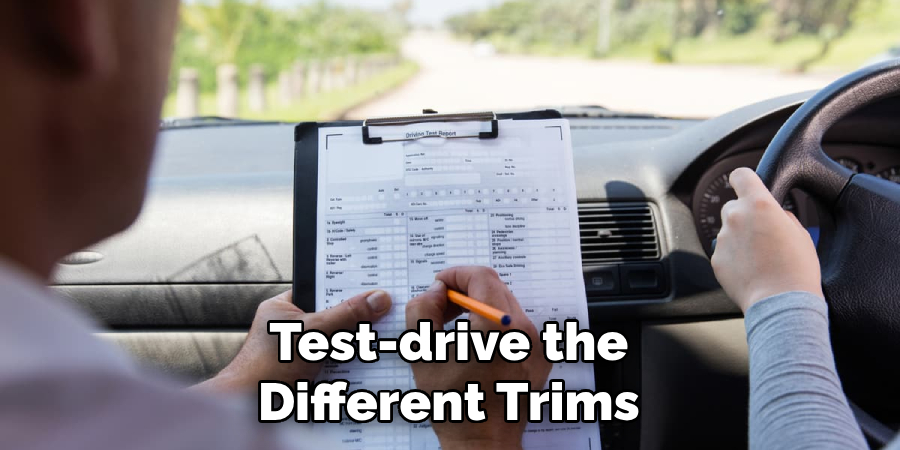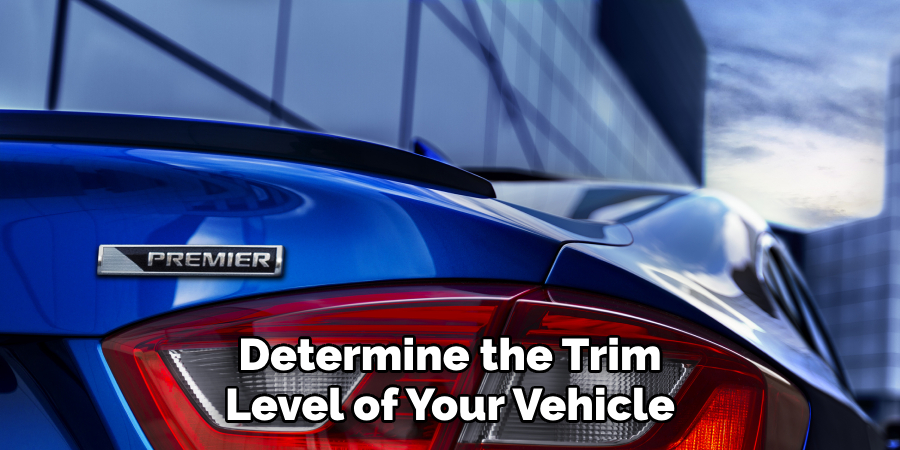Are you in the market for a new car but feel overwhelmed by the number of options available? With so many different makes and models to choose from, it can be difficult to know where to start. One important factor to consider when purchasing a vehicle is the trim level.
Vehicle trim refers to the different variations or packages available for a specific car model. Each trim level offers its own set of features, upgrades, and sometimes even different engine options.

Understanding how to find vehicle trim for your needs can greatly impact your buying experience and ensure you end up with a car that meets all your requirements. In this blog post, we will discuss the importance of vehicle trim levels, how to identify and compare them and provide some useful tips to help you find the perfect trim for your next car purchase.
Why Are Vehicle Trim Levels Important?
Choosing the right vehicle trim level is crucial as it determines the overall performance, comfort, and convenience features of the car. With a variety of options available for each make and model, understanding the differences between them can save you both time and money in the long run.
Moreover, vehicle trims may also affect the resale value of your car. Certain trims may hold their value better over time, while others may depreciate faster. It’s important to consider this when making a purchase decision.
Step-by-step Guidelines on How to Find Vehicle Trim
Step 1: Identify the Make and Model of Your Desired Car
The first step in finding the right vehicle trim is to identify the make and model of the car you are interested in. This will help narrow down your options and ensure that you are looking at the correct trims for that specific vehicle. This information can usually be found on the manufacturer’s website, in a brochure, or by speaking with a salesperson at the dealership.
Step 2: Research Available Trim Levels
Once you have determined the make and model of your desired car, it’s time to research the available trim levels. Most manufacturers offer multiple trims for each model, such as base, mid-level, and top-of-the-line options. The higher the trim level, the more features and upgrades are included. It’s important to compare the differences between each trim to determine which one best suits your needs and budget.

Step 3: Consider Your Budget
As mentioned earlier, different vehicle trims come at different price points. It’s essential to consider your budget when deciding on a trim level. While the features and upgrades in higher trims may be appealing, they can also significantly increase the cost of the car. Be sure to set a budget beforehand and stick to it while browsing different trim levels.
Step 4: Look for Standard Features vs Optional Upgrades
When comparing different vehicle trims, pay attention to which features come standard and which are optional upgrades. Standard features are included in the base price of the car, while optional upgrades will add to the overall cost. Consider which features are must-haves for you and which ones you can live without to determine if a higher trim level is worth the extra cost.
Step 5: Test Drive Different Trims
Once you have narrowed down your options, it’s essential to test-drive the different trims you are considering. This will allow you to get a real feel for the car and how its features and upgrades affect the overall driving experience.
It’s also a good idea to test out any optional upgrades you may be interested in to see if they are worth the extra investment. Make sure to test drive on different road types and conditions to get a comprehensive understanding of the vehicle’s performance.
Following these step-by-step guidelines will help you find the perfect vehicle trim for your needs and budget. Remember to also consider long-term factors such as resale value and maintenance costs when making your decision. With the right information and research, you can confidently choose a vehicle trim that meets all your requirements and enhances your overall driving experience. Happy car shopping!

Additional Tips and Tricks to Find Vehicle Trim
1. Always double-check the trim level on the vehicle’s title and registration documents. This can help ensure that you are looking at the correct trim when searching for information or making a purchase.
2. Look for distinguishing features such as unique badges, emblems, or exterior accents that may be specific to certain trim levels.
3. Check online forums and communities dedicated to discussing specific make and model vehicles. These communities often have members who are knowledgeable about different trim levels and can provide valuable insights.
4. Pay attention to the vehicle’s options and features. Certain options, such as leather seats or a sunroof, may only be available on certain trim levels.
5. Use online resources, such as manufacturer websites or third-party websites that specialize in providing information on different vehicle trims. These resources can also help you compare the features and options of different trim levels.

6. If you are purchasing a used vehicle, ask the seller for the VIN (vehicle identification number) so that you can research the vehicle’s original trim level and options using online databases.
7. Consider taking a test drive in multiple trim levels of the same vehicle to get a better sense of the differences and determine which trim level best suits your needs.
8. If you are unsure about a specific trim level, reach out to the manufacturer or consult with a trusted mechanic for more information.
9. Keep in mind that trim levels may vary between different model years of the same vehicle. Be sure to confirm the trim level on the specific vehicle you are interested in.
10. Lastly, don’t be afraid to ask questions and do your research when it comes to finding the right vehicle trim for you.
Following these tips and tricks can help you narrow down your search and find the perfect vehicle trim that fits your needs and preferences. With a little extra knowledge and effort, you’ll be sure to make an informed decision when it comes to finding the right trim for your vehicle. So, don’t hesitate to take your time and thoroughly research different trims before making a final decision. Happy searching!
Things You Should Consider to Find Vehicle Trim
1. The first thing to consider is the make and model of your vehicle. Different makes and models have different trim levels available, so you need to make sure you are looking at the correct options for your specific vehicle. You can usually find this information in your vehicle manual or by searching online for your specific make and model.
2. Once you have the correct make and model, it’s time to determine the trim level of your vehicle. Trim levels refer to different packages or variations of a particular make and model. Typically, trims are classified as base, mid-level, or high-end options. The higher the trim level, the more features and amenities your vehicle will have.

3. Another important consideration is your budget. Different trim levels come at different price points, so it’s essential to determine how much you are willing or can afford to spend on a new car. It’s also worth researching if there are any financing options available for certain trims that may help make it more affordable.
4. Next, think about your needs and preferences in a vehicle. Are you looking for a basic mode of transportation, or do you want all the bells and whistles? Consider factors like fuel efficiency, safety features, technology options, and comfort features when deciding on a trim level that best suits your lifestyle.
5. It’s also crucial to take a test drive of the different trim levels you are considering. This will allow you to experience firsthand the differences between each option and determine which one feels most comfortable and meets your needs.
6. Do some research on online forums or ask friends and family for their opinions on different trim levels and their experiences with them. Getting feedback from others who have firsthand knowledge of a particular trim can help you make an informed decision.
Following these considerations can help you narrow down your options and find the perfect trim level for your vehicle. Remember to also consider any additional features that may come with a specific trim, such as extended warranties or maintenance plans. Finding the right vehicle trim is an important decision, so take the time to carefully evaluate your options before making a final choice. So, always keep these things in mind when searching for the perfect vehicle trim. Happy driving!
Conclusion
All in all, knowing how to find vehicle trim is important as it helps you make an informed decision when purchasing a car. Understanding the different trim levels and options available can help you find the perfect vehicle that fits your needs and budget.
Additionally, knowing how to decode a vehicle’s VIN can also provide valuable information about the trim level and features of a car. Taking the time to research and compare different trim levels, as well as considering your budget and needs, can help you make an informed decision. So, don’t be afraid to use these tips and tricks in your search for the perfect vehicle trim. Happy car hunting!

About
JeepFixes Team is a skilled author for Jeep Fixes, bringing 6 years of expertise in crafting a wide range of jeep fixes. With a strong background in jeep fixes work, JeepFixes Team’s knowledge spans various types of fixtures, from decorative pieces to functional hardware, blending precision with creativity. His passion for jeep fixes and design has made him a trusted resource in the industry.
Professional Focus:
Expert in Jeep Fixes : JeepFixes Team aesthetic specializes in creating durable and innovative jeep fixes, offering both appeal and functionality. His work reflects a deep understanding of jeep fixes techniques and materials.
Sustainability Advocate : He is dedicated to using sustainable practices, ensuring that every fixture is crafted with eco-friendly methods while maintaining high-quality standards.
In his writing for jeep fixes, JeepFixes Team provides valuable insights into the latest trends, techniques, and practical advice for those passionate about jeep fixes, whether they are professionals or DIY enthusiasts. His focus on combining artistry with engineering helps others discover the true potential of jeep in design.
